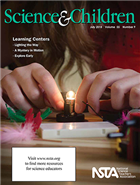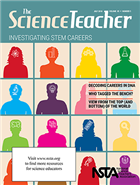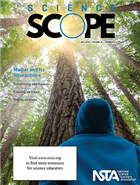Ideas and inspiration from NSTA’s July 2018 K-12 journals
By Mary Bigelow
Posted on 2018-07-15
Regardless of what grade level or subject are you teach, as you skim through the article titles, you may find ideas for lessons that would be interesting your students or the inspiration to adapt/create/share your own.
Special thanks to Linda Froschauer (My Last Editor’s Note)! Under her leadership as editor of Science & Children she has provided all of us with ideas and inspiration! Rather than “retiring,” I suspect she’ll be “retooling” into other ways of contributing to science teaching and learning.
 Science & Children – Learning Centers
Science & Children – Learning Centers
Another big change at S&C is the retirement of Bill Robertson, author of Science 101 which appeared in every issue. In his last column, Science 101: How Do We Best Teach and Learn Science Concepts?, he shares a technique he uses as an introduction to how people learn and how to teach for understanding rather than memorization.
The lessons described in the articles include connections with the NGSS.
- The introductory part of Formative Assessment Probes: Using Formative Assessment Probes to Develop Elementary Learning Stations describes learning stations as more than a collection of activities. The article shows how formative assessments can be used when designing learning stations and includes a probe on magnets.
- Explore Early has a rationale and suggestions for three approaches to exploratory science centers for young students. The authors include photographs and stories of children exploring science concepts in multi-disciplinary centers.
- Learning centers can be a way to address the issue of “not enough time” for science. Lighting the Way to Learning Centers suggests ways to determine which standards could be addressed in centers, which activities would be appropriate, how all students can benefit, and how teachers can organize the center concept, within the context of a center on circuits.
- The case study described in Methods & Strategies: Responsive Teaching and High-Stakes Testing shows that “teaching responsively need not compromise students’ test scores. These findings, along with rich opportunities afforded by teaching responsively, suggest that veering from the standards-mandated curriculum to pursue students’ ideas may not be as risky as many fear.”
- Modeling in Learning Centers describes a series of learning centers that focus model-building and testing as students explore and characterize objects as living, nonliving, natural, or human-made. The article includes key questions for each center.
- A Mystery in Motion illustrates a 5E lesson in which students used motion sensors to graph and predict future motions based on what they observed.
- Learning centers are not a new idea. Renovating Our Science Learning Centers discusses how to adapt traditional centers into informal learning centers that support and challenge students to develop and expand their understanding of science concepts. Weather and natural disasters was the focus of the centers described in the article.
- The Early Years: Engaging Children in Multidisciplinary Learning Centers includes an overview of how learning centers support children’s use of manipulatives, their imaginations, exploratory activities, and interdisciplinary connections. The article includes a detailed description of setting up learning centers, using the topic of seeds.
- In addition to recommending trade books, Teaching Through Trade Books: Star Light, Star Bright has two 5E lessons (Pictures in the Stars K-2) and Stellar Science (3-5) that focus on constellations and studying star charts.
These monthly columns continue to provide background knowledge and classroom ideas:
- Teaching Teachers: Breathing New Life Into Elementary Science Preservice Teacher Education
- The Poetry of Science: Force, Motion, and Energy
- Engineering Encounters: STEM-ify Me: It’s Elementary! Designing Butterfly Wings
For more on the content that provides a context for projects and strategies described in this issue, see the SciLinks topics Butterflies, Constellations, Electric Current, Energy, Forces and Motion, Life Cycle of a Star, Light, Living Things, Magnets, Natural Disasters, Seed Germination, Simple Machines, Stars, Weather
Continue for The Science Teacher and Science Scope.
 The Science Teacher – Investigating STEM Careers
The Science Teacher – Investigating STEM Careers
The Editor’s Corner: A Good Day’s Work discusses reasons to encourage students to consider STEM-related careers:
- This comes at a time when the global knowledge-based economy demands increasing participation in STEM fields, and even many non-STEM occupations require a high level of STEM knowledge and technical expertise.
- Scientific knowledge makes everything—a walk in the woods, reading a newspaper, a family visit to a science museum or beach—simply more interesting.
- The skepticism and critical thinking that are part of the scientific worldview are essential for informed civic participation and evidence-based social discourse.
The lessons described in the articles include connections with the NGSS.
- A teacher-researcher describes the View from the Top (and the Bottom) of the World in terms of climate change in the polar regions. The lesson focuses on students comparing the Antarctic region with other places on Earth and includes links to video interviews with scientists who are studying polar climate change.
- Kick up your career preparations with the ideas in On the Job. This project involves a job-shadowing program at a zoo, with suggestions on adapting the strategies for other shadowing/internship opportunities.
- As part of unit on heredity, students explored Decoding Careers in DNA as they took on the role of code-breakers. The article includes a rubric for a Claims-Evidence-Reasoning (CER) framework.
- Who Tagged the Bench? describes five activities in which students collect and analyze data throughout the year, practicing their skills. The authors include a detailed overview of the activities, including a culminating investigation that required students to analyze and interpret data from a new situation.
- Creative Assessments includes a strategy (RAFT) for using writing prompts as a formative assessment. As the example show, students can be both creative and scientifically accurate as they write about what they learned about motion.
- Focus on Physics: Bow Waves to Sonic Booms reviews the characteristics of waves with simple diagrams and examples.
- Recognizing patterns and trends is a NGSS crosscutting concept. Science 2.0: Map My Data illustrates how mapping technology can be used to identify and visualize patterns that exist in a data set.
- Career of the Month: Audio Engineer has suggestions for integrating technology and the arts into a career. (This column features a different STEM career each month. Here is a list from the 2013-2018 TST issues.)
- Perhaps the historic posters in Right to the Source: Encouraging Exploration—The WPA Poster Project would encourage students to create their own.
For more on the content that provides a context for projects and strategies described in this issue, see the SciLinks topics Biology Careers, Careers in Chemistry, Careers in Earth Science, Careers in Life Science, Careers in Environmental Science, Careers in Physics, DNA, Doppler Effect, Motion, Nature of Waves, Paper Chromatography, Public Health Careers, Spectra of Elements, Wave Properties, Wavelength, Wildlife Biologists
 Science Scope – Matter and Its Interactions
Science Scope – Matter and Its Interactions
From the Editor’s Desk: The Meaningful World of Matter: The world is made up of matter—everything we come in contact with, see, and touch embodies properties that make that matter unique. Whether it is plastics, medicines, or even automobile paint, we manipulate matter for the purpose of improving our lives. It can be challenging, however, to take something that can be as abstract as matter and make it meaningful for middle school students.
Articles in this issue that describe lessons include a helpful sidebar (“At a Glance”) documenting the big idea, essential pre-knowledge, time, and cost. The lessons also include connections with the NGSS.
- Help students investigate and understand exothermic and endothermic process with an interesting question: How Will We Freeze the Ice Cream? The lesson incorporates knowledge probing, learning stations, measuring, experimental design…and ice cream!
- While Making Mixtures, students use models to explain what happens when materials are mixed with water.
- Where Does a Tree Get Its Mass? addresses student misconceptions about the relationship between plant growth and photosynthesis.
- A teacher demonstration can be adapted into an opportunity for student discussion or an opportunity for formative assessment. Classic Lessons 2.0: The Discovery Demonstration uses an example that incorporates modeling, prediction, observation, and explanation.
- “States of matter” is the focus of the investigation in Disequilibrium: Oobleck: Is It a Solid or Liquid?
- Commentary: “When You Walk Into This Room, You’re Scientists!” promotes developing science-linked identities in students, including those who may not see themselves as scientists. .
- Science for All: Ready, Fire, Aim! has ideas for managing student behavior during class activities.
- Do your students have difficulty identifying variables during an investigation? Teacher to Teacher: Supporting Students With the Four Question Strategy includes suggestions for helping students plan and conduct investigations with their own experimental designs.
- If you live near an ocean, the Great Eggcase Hunt described in Citizen Science: Citizen Science at the Shore could be interesting to your students.
These monthly columns continue to provide background knowledge and classroom ideas:
- Listserv Roundup: A Short Guide to Genius Hour Makerspaces
- Scope on the Skies: Return to Sender (part 1)
- Integrating Technology: Depth of Knowledge and Conceptual Understanding
- Practical Research: Help! I’ve Been Asked to Coach a Robotics Team
For more on the content that provides a context for projects and strategies described in this issue, see the SciLinks topics Catapults, Chemical Reactions, Density, Exothermic and Endothermic Reactions, Mass, Matter, Photosynthesis, Properties of Matter, Robot, Solutions, States of Matter
Disclaimer: The views expressed in this blog post are those of the author(s) and do not necessarily reflect the official position of the National Science Teaching Association (NSTA).

